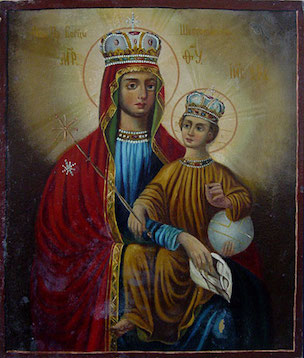
The Shestokhovsk ("Hearth"), or Sheltomezhsk, Icon of the Mother of God
Commemorated on March 6
The Shestokhovsk ("Hearth"), or Sheltomezhsk, Icon of the Mother of God revealed itself in the mid XVIII Century at Moscow, in the family of a certain Nikolai Dimitrievich Skripitsyn. One time a servant girl, whom they called blest, saw in a dream that in a stove-chimney was hidden an icon of the Most Holy Mother of God. The household paid no attention to her tale of this amazing dream, until a linen bundle fell down on the hearth-stove the next day. In it was a fairly large image of the Mother of God (approximately 2 by 1.5 meter). At the right hand of the Mother of God were seen burn‑marks, evidencing that although it had been in a fire, the holy icon miraculously had not burnt. The precious icon, receiving the name "Shestokhovsk ("Hearth", from the word "Shestok" meaning "Hearth"), was elegantly adorned by the household and venerated with the deepest reverence. Before his death, the owner of the house bestowed it in blessing upon his children.

Unable to decide to
whom should belong this holy icon, the heirs gave it over to a church in the
Sheltomezha village of the Tver gubernia, from which it received its second
name – Sheltomezhsk.
Glorified by many a
miracle, church processions were made carrying the ancient icon far about
through the districts of the Tver diocese, for healing the sick and conquering
evil spirits.
In the year 1887, in
honour of the wonderworking icon, in the village of Sheltomezha was founded the
Shestokhovsk Ascension women's monastery.
© 1996-2001 by translator Fr. S. Janos.